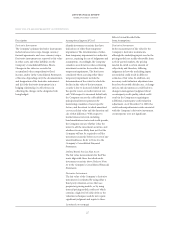American Express 2009 Annual Report Download - page 26
Download and view the complete annual report
Please find page 26 of the 2009 American Express annual report below. You can navigate through the pages in the report by either clicking on the pages listed below, or by using the keyword search tool below to find specific information within the annual report.
2009 FINANCIAL REVIEW
AMERICAN EXPRESS COMPANY
RESERVES FOR MEMBERSHIP REWARDS COSTS
Description Assumptions/Approach Used
Effect if Actual Results Differ
from Assumptions
The Membership Rewards program is the
largest card-based rewards program in the
industry. Eligible cardmembers can earn points
for purchases charged and many of the
Company’s card products offer the ability to
earn bonus points for certain types of
purchases. Membership Rewards points are
redeemable for a broad variety of rewards
including travel, entertainment, retail
certificates and merchandise.
Points typically do not expire and there is
no limit on the number of points a cardmember
may earn. A large majority of spending by
eligible cardmembers earns points under the
program. While cardmember spend,
redemption rates, and the related expense have
increased, the Company believes it has
historically benefited through higher revenues,
lower cardmember attrition and credit losses
and more timely payments.
The Company establishes balance sheet
reserves that represent the estimated future cost
of points earned to date that are ultimately
expected to be redeemed. These reserves reflect
management’s judgment regarding overall
adequacy. The provision for the cost of
Membership Rewards is included in marketing,
promotion, rewards and cardmember services
expenses.
A weighted-average cost per point redeemed
during the previous 12 months, adjusted as
appropriate for recent changes in
redemption costs, is used to approximate
future redemption costs and is affected by
the mix of rewards redeemed. Management
uses models to estimate ultimate
redemption rates based on historical
redemption statistics, card product type,
year of program enrollment, enrollment
tenure, and card spend levels. These models
incorporate sophisticated statistical and
actuarial techniques to estimate ultimate
redemption rates of points earned to date by
current cardmembers given redemption
trends and projected future redemption
behavior.
The global ultimate redemption rate
assumption for current participants is
approximately 90 percent. The Company
continually evaluates its reserve
methodology and assumptions based on
developments in redemption patterns, cost
per point redeemed, contract changes, and
other factors.
The reserve for the estimated cost of
points expected to be redeemed is
impacted over time by enrollment levels,
the number of points earned and
redeemed, and the weighted-average cost
per point, which is influenced by
redemption choices made by
cardmembers, reward offerings by
partners and other Membership Rewards
program changes. The reserve is most
sensitive to changes in the estimated
ultimate redemption rate. This rate is
based on the expectation that a large
majority of all points earned will
eventually be redeemed.
As of December 31, 2009, if the
ultimate redemption rate of current
enrollees increased by 100 basis points,
the balance sheet reserve and
corresponding provision for the cost of
Membership Rewards would each
increase by approximately $250 million.
24
























